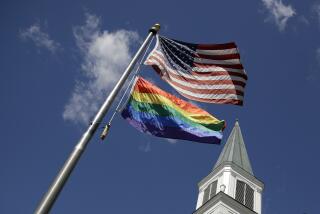Working Toward Greater Unity
- Share via
Ever since the modern ecumenical movement took root 50 years ago, the two largest Christian groups in the United States--Roman Catholics and evangelical Protestants--have been missing from the table.
That may change after a recent high-level meeting in Chicago at which Catholic, evangelical and mainline Protestant leaders formed what is being called Christian Churches Together in the USA and agreed to work for greater unity among major U.S. Christian churches.
The 23 groups represented ranged from the Episcopalians and United Church of Christ on the theological left, to the Roman Catholics and the African Methodist Episcopal Church in the center, to the Salvation Army and the Korean Presbyterian Church on the right.
“We celebrate the unique traditions, gifts and charisms of our respective faith communities,” said a joint statement adopted at last month’s meeting. “We also acknowledge that when our differences create unnecessary divisions, our witness to the Gospel of Jesus Christ is distorted.”
If the 23 groups can agree to establish a new organization, it will signal a seismic shift in American church relations. Most leaders said a “new something” could emerge within five years, perhaps sooner.
For years, evangelicals and Catholics have been suspicious of the liberal-leaning National Council of Churches, and groups belonging to the council have felt their influence to be diminished by the growing clout of Catholics and evangelicals.
The Rev. Bob Edgar, the council’s general secretary, began the discussions two years ago and made it clear that he was willing to sacrifice the venerable council in order to attract Catholics and evangelicals to a bigger ecumenical table. An initial meeting was held last September in Baltimore.
At the Chicago meeting, which was intentionally kept quiet, Edgar said all sides agreed that the time had come to bury past grudges and work together on common issues of concern, such as poverty, saving the environment and fighting pornography.
“If the Russians and the Americans can live and work together in outer space, why can’t Christians find a way to work together down here?” Edgar asked.
Under the loose framework of an initial mission statement, the new body would be bound by traditional Christian beliefs in the Trinity, salvation through Jesus Christ, “common prayer, speaking to society with a common voice” and “promoting the common good of society.”
Previous attempts to speak with a common voice, however, have been problematic. In 2000, a planned statement on marriage involving the National Council of Churches, Southern Baptist Convention, Catholic bishops and the National Assn. of Evangelicals was shelved when Edgar withdrew his support for fear that it could be used against gays and lesbians. This time, he said, the groups are focusing on areas of agreement, not disagreement.
Bishop Tod Brown of the Diocese of Orange and the lead ecumenical liaison for the U.S. Conference of Catholic Bishops, said the need for a wider ecumenical table is clear: “There is no broad-based Christian churches voice in this country, and I think we [Catholics] have our voice, and the [National Council of Churches] has a voice, and sometimes there are some evangelical voices. But there isn’t any gathering that represents most or all of those groups.”
With Brown’s and Baltimore Cardinal William Keeler’s participation, the Catholics are clearly on board. The evangelicals, however, may be harder fish to catch.
Commissioner John Busby, the national commander for the Salvation Army, is a negotiator trying to bring the traditionally conservative evangelicals on board.
He said initial reactions have been positive, although some groups “certainly have reservations.”
Organizers also hope to include fast-growing Pentecostal churches and “parachurch” ministries such as Habitat for Humanity and umbrella groups representing independent megachurches.
Busby said everything in the new organization is tentative, in an effort to make it accessible to other churches that have not signed on yet. “The safest thing for us to do,” he said, “is take it one meeting at a time and look at concerns as new people join us, and try to deal with those one at a time.”
Church leaders, however, are decidedly optimistic and feel a sense of momentum.
More to Read
Sign up for Essential California
The most important California stories and recommendations in your inbox every morning.
You may occasionally receive promotional content from the Los Angeles Times.













